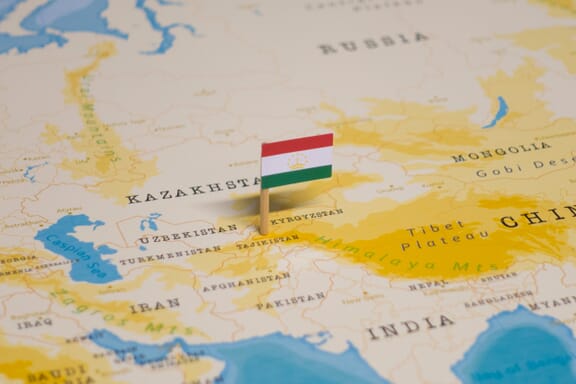Tajikistan is located in the Central & South Asia region at latitude 38.861034 and longitude 71.276093 and is part of the Asian continent.
The DMS coordinates for the center of the country are:
- 38° 51' 39.72'' N
- 71° 16' 33.93'' E
You can see the location of Tajikistan on the world map below:

Tajikistan Neighboring Countries
The neighboring countries of Tajikistan (TJ) are:
- Afghanistan (AF)
- China (CN)
- Kyrgyzstan (KG)
- Uzbekistan (UZ)
Tajikistan is a landlocked country, which means it does not have direct access to the open ocean.
Tajikistan Related Content
Tajikistan Key Facts
| Country | Tajikistan |
| Coordinates | Latitude: 38.861034 Longitude: 71.276093 |
| Country Codes | Alpha 2: TJ Alpha 3: TJK |
| Country Flag Emoji | 🇹🇯 |
| Int. Phone Prefix | +992 |
| Capital city | Dushanbe |
| Continent Subcontinent | Asia Central & South Asia |
| Country Area | 144,100 sq km |
| Population 2021 | 9,749,625 World Rank: 93 |
| Median Age | 21.5 |
| Life expectancy | 71.6 |
| Major languages | Tajik (official) 84.4%, Uzbek 11.9%, Kyrgyz .8%, Russian .5%, other 2.4% (2010 est.) |
| UTC/GMT Time | Number of time zones: 1
|
| Internet TLD | .tj |
| Biggest Airport | Dushanbe Airport (DYU) |
| Average temperature | 6.40 °C 43.52 °F |
| Administrative Divisions | 1 autonomous region 2 regions 1 capital territory 1 district under republic administration |
| Political system | Presidential representative democratic republic |
Tajikistan Economy Facts
| World Bank Income Group | Lower middle income |
| World Bank Region | Europe & Central Asia |
| Currency | Somoni (TJS) |
| GDP in 2020 | $8.1 (billions of USD) World Rank: 147 |
| GDP per capita in 2020 | $853 World Rank: 175 |
| Major Industries / Economic Sectors | Manufacturing, services, agriculture, energy |
| Top 5 Import Countries | China, Russia, Kazakhstan, Uzbekistan, Turkey |
| Top 5 Export Countries | China, Russia, Kazakhstan, Kyrgyzstan, Uzbekistan |
Biggest Cities in Tajikistan
Here are the largest cities in Tajikistan based on 2021 data:
| City | Population |
|---|
| Dushanbe | 778,500 | Khujand | 181,600 | Kulob | 95,000 | Bokhtar | 75,450 | Istaravshan | 57,400 | Konibodom | 50,400 | Tursunzoda | 46,700 | Vahdat | 40,600 | Isfara | 40,000 | Panjakent | 33,000 |
Map of Tajikistan with the Largest Cities
Other Countries in the Central & South Asia Region
Image Sources and Copyright Information
- Pin on World Map Indicating Tajikistan Location: © hyotographics/Shutterstock